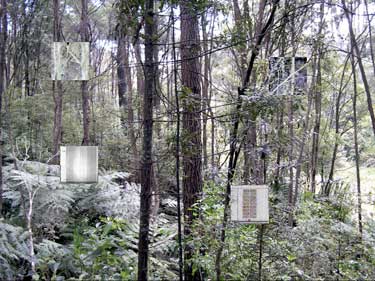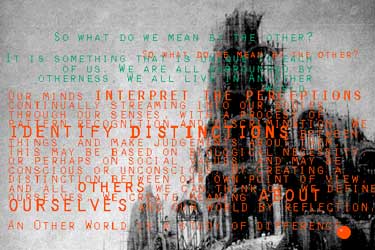This website explores the work of Nigel Brookes - software, images, history, and science.
Gr. protos, first.
Other sites Nigel is involved with include:
I have been making multimedia software art since 1979 - here's some of the highlights of hundreds of experiments - some are available here for download, but others require various long-dead operating systems...
Probe
 Probe is multimedia software art that explores the edge where technology feeds back on biology. Unlike Root however, Probe is interactive so you too can play.
Probe is multimedia software art that explores the edge where technology feeds back on biology. Unlike Root however, Probe is interactive so you too can play.
As the work runs, up to four animated 'probes' can be used to remix the original multitrack sound files of the song "Help Me Somebody", from the album "My Life In The Bush Of Ghosts" by Brian Eno and David Byrne.
The 'probes' contain images from the world of modern biological science, over a background of unspoilt New Zealand bush...

There are versions of the software for both Macintosh (Mac OS X 10.1.4 or later) and Windows (ME/98/NT/2000/XP) platforms. Both also require QuickTime 6.0 or greater.
Probe was presented at the 2007 Infinite Composing Festival, Amsterdam.
- Download for Macintosh OS X You can download a Macintosh OS X version of Probe for free here.
- Download for Windows You can download a Windows version of Probe for free here.
Root
 Like Probe, Root is generative multimedia software art that explores the edge where biology meets technology.
Like Probe, Root is generative multimedia software art that explores the edge where biology meets technology.
Randomly animated images from the world of molecular biology form a photomosaic of a fern root, whilst remixing the original multitrack sound files of the song "A Secret Life", from the album "My Life In The Bush Of Ghosts" by Brian Eno and David Byrne.
The fern root photomosaic image is broken into a grid of 9 independently animated subimages. Each stops and starts randomly, picking a new music track from the multitrack pool each time, thus creating variability both in the appearance of the whole image, and in the composition of the music.
There are versions of the software for both Macintosh (Mac OS X 10.1.4 or later) and Windows (ME/98/NT/2000/XP) platforms. Both also require QuickTime 6.0 or greater.
Leaving the work running creates the most surprising visual and musical combinations...
Root was presented at the 2007 Infinite Composing Festival, Amsterdam.
- Download for Macintosh OS X You can download a Macintosh OS X version of Root for free here.
- Download for Windows You can download a Windows version of Root for free here.
Azimuth (2005)
 Interactive Azimuth was projected above the Auckland Wind Orchestra's performance of Jeni Little's Azimuth.
Interactive Azimuth was projected above the Auckland Wind Orchestra's performance of Jeni Little's Azimuth.
A photomosaic sun arcs across the sky, slowly accelerating as it changes images from geological, to biological, to technological, then explodes.
The image changes and ultimate explosion are controlled via the keyboard.
On A Life Edge (2004)
 By using the molecular biology technique of blotting as a visual metaphor, this artwork raises questions about the impact of technology on the bios. Blots are analytical methods of separating proteins such as RNA or DNA across a charged matrix, and are a seminal tool in the biological revolution.
By using the molecular biology technique of blotting as a visual metaphor, this artwork raises questions about the impact of technology on the bios. Blots are analytical methods of separating proteins such as RNA or DNA across a charged matrix, and are a seminal tool in the biological revolution.
Visually, On A Life Edge consists of a series of eight words - which are synonyms of the word 'edge' - moving random distances from the left hand side of the screen over a grid. Each begins as a blur and comes into focus as it completes its traverse across the screen. Each word has a different typeface, and changes colour as it moves. The layering effect of the graphics as they move over each other creates other unpredictable visual effects. All the visual components were created using Photoshop.
The music consists of eight component sonic molecules made by Jeni Little, each developing in synchrony with its associated word. They were notated and rendered using Sibelius and Kontakt, then processed with Peak.
There are two operational modes - generative and interactive. The generative mode creates surprising music as the computer randomly turns the word/sound molecules on and off. The distance and speed each word moves across the screen is also randomly controlled. In contrast, the interactive mode invites the audience to control when each word/sound molecule is switched on/off, via either the keyboard or the mouse.
mBOX (1996-9)
 Interactive music software. An interactive virtual cube - each face a different musical instrument - Tirade, Throng, Fracas, Space, Wrought, Spine, Riff.
Interactive music software. An interactive virtual cube - each face a different musical instrument - Tirade, Throng, Fracas, Space, Wrought, Spine, Riff.
Every instrument had a unique set of sounds and way of playing them.
In 1997 Fracas was awarded second place in Art/Experimental category of Interactive New Zealand's ICON Awards. The entire mBox suite was presented as an interactive installation running on a Power Computing Macintosh clone, at the Soliton multimedia art event, Auckland in 1998. A more developed version of the Tirade and Throng instruments was presented as an interactive installation at the 1999 Soliton multimedia art event, Auckland.
An Other World (1994-5)
 An interactive multimedia exploration of “Otherness”.
An interactive multimedia exploration of “Otherness”.
From the original ReadMe: “An Other World is an immense navigable multimedia essay about how global/local culture defines everyday reality by creating limits of acceptability. It consists of over 800 'pages' of text, image, sound, movies, and computer generated speech, arranged into 16 broad areas: evil (the religious other), pain, enemies (of states), mind (insanity and talent), meta (overcoding systems), dirt, sub (peering between the cracks in the dominant), secrets, extraterrestrials (other than Earth), criminality, virtuality (simulacra), our bodies (fat and modification), life itself (propagative models opposed to filiation: infection, parasitism, etc.), pharmacology (our relationship with the chemical other), death, and violence (violation of the sacred). Within each area, 'pages' are spatially arranged in metaphorical media landscapes, which allow the participant to surf many routes through the work.

In addition to being an exploration of ideas of Otherness, An Other World is a model of future possibility: a plug-in repository of cultural criticism, where point of view is everything and all that exists are instant connections in a database of human knowledge. This project presents only ideas of what might constitute An Other World, exploring them with an assemblage of fragments of knowledge.
The principal interface of An Other World consists of sixteen screens connected in such a way as to simulate the surface of a large (virtual) sphere. The explorer moves over the surface, which is presented as images of other earths, both historical (the movement of Ghengis Khan's nomadic tribes across the Asian steppe in 1227) and newly visualized (a pseudo-color photograph of Tokyo, taken from an orbiting satellite).
To the sound of a musical refrain, the explorer is presented with a second single metaphorical image floating on each surface or region: a button and point of entry into a specific aspect of our exploration of Otherness. Clicking on these images punches through the surface of An Other World, allowing exploration of the labyrinths below.”
An Other World was originally completed to run on Macintosh System 7.1. It was constructed in SuperCard. Images were created using Photoshop and Freehand, and the music was created with SoundEdit Pro. It was created by Nigel Brookes (concept, research, scanning, scripting), Mark Bradford (research, design, typography), and Jeni Little (research, music).
Two versions of the work were made. The first version in 1994 was a winner in the international multimedia competition New Voices New Visions, run by the Voyager Company, Interval Research, and WIRED magazine. It was exhibited twice in the USA (Lincoln Center and Stanford University) and published along with the other winners on CD-ROM by the Voyager Company. The second greatly expanded and redesigned version a year later was exhibited as a large room installation at Artspace, Auckland. It won the Telecommunications Users Association of New Zealand award for Art or Experimental computer based work, and was a finalist in the 1995 New Voices New Visions competition, USA.
Some Post-linear Attitude (1993)
An interactive kiosk installation, made in SuperCard, and presented at Synaethesia, Waikato Museum of Art, in black and white on a Macintosh II. Mouseclicks controlled an evolving slideshow of images and typographic texts from the Textures Collective.